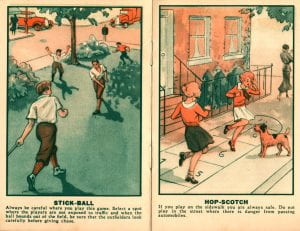Before widespread automobility, the street had been a shared public space – for pedestrians, bicycles, streetcars, horse-drawn vehicles – even a space for children’s play. The mass adoption of the automobile marked a sharp turn in thinking about who had the right to the street, and in the 1910s and 1920s it became a place increasingly dominated by the automobile.
During that transition, the street was an especially dangerous place, and, as they are today, children were particularly vulnerable to the dangers of automobile traffic. It was estimated that the number of fatalities from traffic crashes in the United States between 1920 and 1929 was as high as 210,000 – three, or even four times as high as the previous decade[i] – and that sixty percent of victims were children under the age of nine[ii]. Automobile manufacturers and advocates introduced safety campaigns for children, which ostensibly served as educational tools for traffic safety – but also worked to shift the burden of safety from drivers to pedestrians. Children were pushed from what had once been shared public space, creating questions about who had the right to the street.
Two new acquisitions from the Northwestern University Transportation Library illustrate this moment in the history of automobility.

Play Safe with the Games We Love, published by the Knights Life Insurance Company of America, published c.1920, encouraged safety practices for children, with a particular focus on street safety. Whereas children had previously used the street for a place to play, they were relegated to playgrounds and sidewalks, making the street strictly the domain of the automobile.

__________________________________________
Safety Songs, a 1940s collection of mimeographed pages distributed by the Automobile Club of Michigan, included dozens of songs themed around traffic safety. One song, to the tune of “Bring Back My Bonnie,” included the following lyrics.
My Bonnie lies over the ocean
My Bonnie was careless you see,
My Bonnie was not careful at crosswalks,
Oh Bring Back My Bonnie to Me

The burden of safety was shifted from the driver of the automobile, the member of the Automobile Club for Michigan, to Bonnie, who was just trying to cross the street safely.
__________________________________________
Both items may be viewed by appointment at the Northwestern University Transportation Library. For more information on the Transportation Library’s services or collections, please visit our website or contact us at transportationlibrary@northwestern.edu. You can also find us on Instagram and Twitter.
_____________________________
[i] https://www.jstor.org/stable/40061474
[ii] https://www.detroitnews.com/story/news/local/michigan-history/2015/04/26/auto-traffic-history-detroit/26312107/
